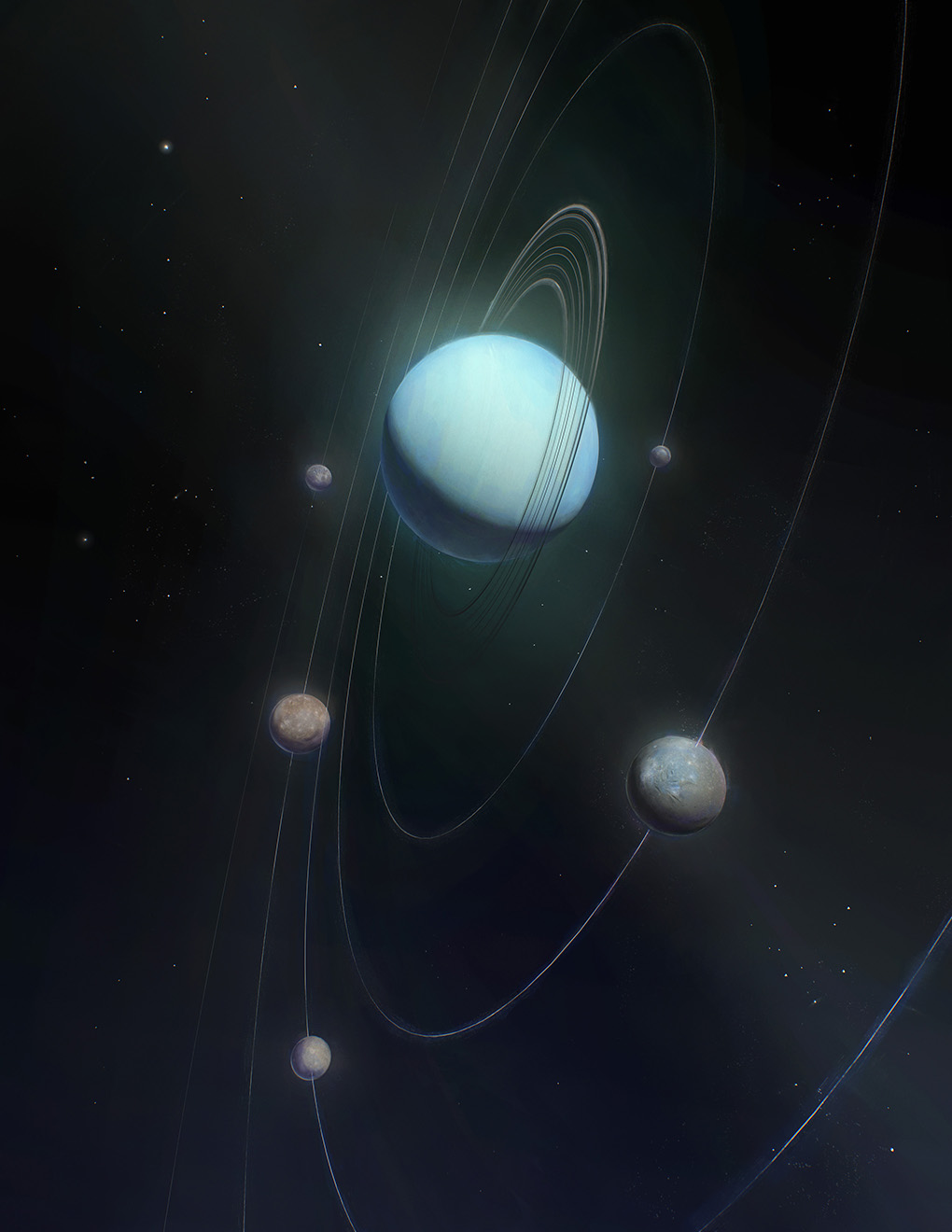News
Two of Uranus’ Moons May Harbor Active Oceans, Radiation Data Suggests

An artist’s impression of Uranus and its five largest moons (innermost to outermost) Miranda, Ariel, Umbriel, Titania and Oberon.
Credit: NASA/Johns Hopkins APL/Mike Yakovlev
Jeremy Rehm
Key Takeaways
- Mysterious features in the radiation measurements that NASA’s Voyager 2 spacecraft collected around Uranus suggest there is more going on in the planet’s space environment than previously thought.
- New results suggest Uranus’ moons Ariel and/or Miranda may be releasing some of their material into space.
- The results feed into a growing push to return to Uranus and Neptune, and recent mission prioritization from the National Academies of Sciences, Engineering and Medicine.
Uranus — the turquoise, tilted oddball of the solar system — may have just joined ranks with Jupiter, Saturn and Neptune as host to at least one icy moon that’s pumping particles into its planetary system.
In a new study led by the Johns Hopkins Applied Physics Laboratory (APL) in Laurel, Maryland, researchers reanalyzed nearly 40-year-old energetic particle and magnetic field data taken by NASA’s Voyager 2 spacecraft — the only spacecraft so far to have gone to Uranus. Their results, published April 17 in the journal Geophysical Research Letters, suggest that one or two of Uranus’ 27 moons — Ariel and/or Miranda — are adding plasma into the space environment through an unknown and mysterious mechanism. One tantalizing explanation is that one or both moons have oceans beneath their icy surfaces and are actively spewing material, possibly through plumes.
The team presented their results at the annual Lunar and Planetary Science Conference on March 16.
“It isn’t uncommon that energetic particle measurements are a forerunner to discovering an ocean world,” said Ian Cohen, a space scientist at APL and the lead author of the new study.
For example, particle and magnetic field data provided some of the first hints that led to identifying the solar system’s two unequivocal ocean moons, Jupiter’s Europa and Saturn’s Enceladus. That data provided the first compelling evidence that Europa and Enceladus were sources of particles and plasma, likely originating from salty liquid oceans beneath their icy surfaces.
“We’ve been making this case for a few years now that energetic particle and electromagnetic field measurements are important not just for understanding the space environment but also for contributing to the grander planetary science investigation,” Cohen said. “Turns out that can even be the case for data that are older than I am. It just goes to show how valuable it can be to go to a system and explore it first-hand.”
Particle Puzzle
Growing momentum for a return mission to Uranus and Neptune has spurred several research teams to dive back into the old flyby data, sometimes leading to new finds. Those influenced a panel of planetary scientists last spring to recommend a $4.2 billion flagship mission to Uranus as NASA’s next major planetary mission over the coming decade, the benefits of which APL’s Kathy Mandt recently detailed in the journal Science.
Feeding into that thrust, Cohen and his colleagues dove back into particle data from the APL-built Low-Energy Charged Particle (LECP) instrument on Voyager 2, and they found something peculiar: a trapped population of energetic particles the spacecraft had observed while departing Uranus.
“What was interesting was that these particles were so extremely confined near Uranus’ magnetic equator,” Cohen said. Magnetic waves within the system would normally cause them to spread out in latitude, he explained, but these particles were all cramped near the equator between the moons Ariel and Miranda.
Scientists originally attributed these features to Voyager 2’s possibly having flown through a chance stream of plasma being “injected” from the distant tail of the planet’s magnetosphere. But that explanation doesn’t hold, Cohen said. “An injection would normally have a much broader spread of particles than what was observed.”
It became a bit of a whodunit. Using simple physical models and leveraging nearly 40 years of knowledge since, the team tried to recreate the Voyager 2 observations. They determined the true explanation had to include both a strong, consistent source of particles and a specific mechanism to energize them. After considering several possibilities, they concluded that the particles most likely came from a nearby moon.
The team suspects the particles arise from Ariel and/or Miranda through either a vapor plume similar to that seen on Enceladus or through sputtering — a process where high-energy particles hit a surface, ejecting other particles into space. “Right now, it’s about 50-50 whether it’s just one or the other,” Cohen said.
Regardless, modeling suggests the energizing mechanism would be the same: A constant stream of particles flows from the moons into space, where they create electromagnetic waves. Those waves accelerate some small fraction of the particles to energies that LECP could detect. This process, the team believes, kept the particles seen by LECP so narrowly trapped.
However, with only a single observation of the region and no data about the composition of the plasma or measurements of the full range of electromagnetic waves within it, Cohen noted, there’s no way to definitively determine the source of the particles.
Yet scientists have already suspected Uranus’ five largest moons — Ariel and Miranda included — may have subsurface oceans. Voyager 2 images of both moons show physical signs of geologic resurfacing, including possible eruptions of water that froze on the surface.
“The data are consistent with the very exciting potential of there being an active ocean moon there,” Cohen said. “We can always do more comprehensive modeling, but until we have new data, the conclusion will always be limited.”
Areas of Impact
The Applied Physics Laboratory, a not-for-profit division of The Johns Hopkins University, meets critical national challenges through the innovative application of science and technology. For more information, visit www.jhuapl.edu.